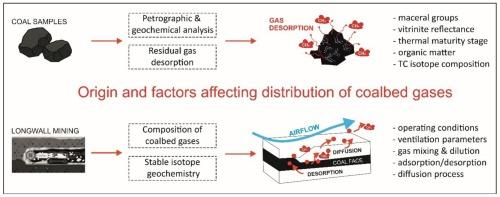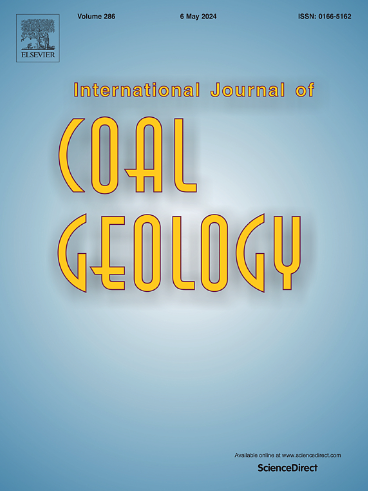认识长壁开采煤层气分布:地球化学和同位素方法
IF 5.7
2区 工程技术
Q2 ENERGY & FUELS
引用次数: 0
摘要
煤层气在能源资源潜力和环境与矿山安全战略中都具有重要作用。尽管对煤层气成因进行了大量研究,但在活跃开采环境下,煤成熟度、瓦斯运移过程和矿井通风的综合影响仍未得到充分认识。本研究结合了长壁工作面开采初期和后期收集的煤层气分子和稳定碳、氢同位素分析,以及波兰上西里西亚煤盆地新采煤的岩石学和地球化学特征。对新采煤进行有机岩石学和生物标志物分析,发现富镜质组烟煤处于油窗成熟度峰值。从煤层钻孔的气体组成来看,甲烷是主要成分(高达87%),其次是二氧化碳(高达2.3%),较重的碳氢化合物(C2−C6)含量较低(0.1 - 1.5%)。在井内的复杂气体混合物中还发现了硫(噻吩)和氮(吡啶)、氯化(1,2- dce)化合物、含氧有机气体(乙酸)、二甲基硫化物(DMS)以及部分邻甲酚、四氢呋喃、甲醛和异丙烯示踪剂。长壁煤工作面甲烷同位素数据δ13C平均值为- 48.1±0.7‰,δ2H平均值为- 192.1±7.1‰,煤成熟度镜质组反射率为0.75±0.02%。这些煤层气分子和同位素数据暗示了煤层气的热成因,并在热系统中留下了生物降解的指纹。井眼微量亏缺同位素(δ13C:−50.9±0.2‰,δ2H:−194.2±2.8‰)表明裂隙中存在游离气。研究发现,长壁盘上气体组成和同位素变化的空间变化是由工作面通风气流驱动的。从主入口到尾入口气流路径上的同位素变化强调了解吸和扩散等二次过程的影响。同位素轻的12CH4分子优先损失,特别是在天然气聚集带(尾门),这与连续破碎煤样的实验室解吸实验结果一致。主动开采条件下δ2H-CH4模式较少,反映了瓦斯混合、现场条件和煤矿作业参数的综合影响。本文章由计算机程序翻译,如有差异,请以英文原文为准。

Understanding coalbed gas distribution from longwall mining: Geochemical and isotopic approach
Coalbed methane plays a critical role in both energy resource potential and environmental and mine safety strategies. Despite much research has been done on coalbed gas origin, the combined effects of coal maturity, gas migration processes, and mine ventilation in an active mining environment are still not fully understood. This study combined molecular and stable carbon and hydrogen isotope analyses of coalbed gases collected along the longwall coal face during the early and final stages of operation, with petrographic and geochemical characteristics of freshly mined coal from the Upper Silesian Coal Basin, Poland. Complementary organic petrography and biomarker analysis performed on freshly mined coal revealed that the vitrinite-rich bituminous coal is at peak oil-window maturity. Gas composition from a borehole in the coal seam indicated methane as the dominant component (up to 87 %), with contributions from carbon dioxide (up to 2.3 %) and lower amounts (0.1–1.5 %) of heavier hydrocarbons (C2 − C6). Heterocyclic species of sulfur (thiophene) and nitrogen (pyridine), chlorinated (1,2-DCE) compounds, oxygen-bearing organic gases (acetic acid), dimethyl sulfide (DMS), and some portion of ortho-cresol, tetrahydrofuran, formaldehyde, and cumene tracers were also found in the complex gas mixtures from the borehole.
Isotopic data of methane in the examined longwall coal face averaged at −48.1 ± 0.7 ‰ for δ13C and − 192.1 ± 7.1 ‰ for δ2H and coal maturity vitrinite reflectance at 0.75 ± 0.02 %. These molecular and isotopic coalbed gas data implied a thermogenic origin of the coalbed methane, with fingerprints of biodegradation in thermogenic system. Slightly depleted isotope values from the borehole under examination (δ13C: −50.9 ± 0.2 ‰ and δ2H: −194.2 ± 2.8 ‰) suggested the presence of free gas stored in the coal fractures. Spatial variations in gas composition and isotopic shifts across the longwall panel were found to be driven by ventilating airflow supplied to the working face. Isotope alteration along airflow path from main- to tailgate entries emphasized the influence of secondary processes, such as desorption and diffusion. Preferential loss of isotopically light 12CH4 molecules, especially at gas accumulation zones (tailgate), aligns with findings from laboratory desorption experiment on successively crushed coal samples. In contrast, less systematic δ2H-CH4 patterns under active mining reflected the combined effects of gas mixing, site-specific conditions, and parameters of coal mine operations.
求助全文
通过发布文献求助,成功后即可免费获取论文全文。
去求助
来源期刊

International Journal of Coal Geology
工程技术-地球科学综合
CiteScore
11.00
自引率
14.30%
发文量
145
审稿时长
38 days
期刊介绍:
The International Journal of Coal Geology deals with fundamental and applied aspects of the geology and petrology of coal, oil/gas source rocks and shale gas resources. The journal aims to advance the exploration, exploitation and utilization of these resources, and to stimulate environmental awareness as well as advancement of engineering for effective resource management.
 求助内容:
求助内容: 应助结果提醒方式:
应助结果提醒方式:


